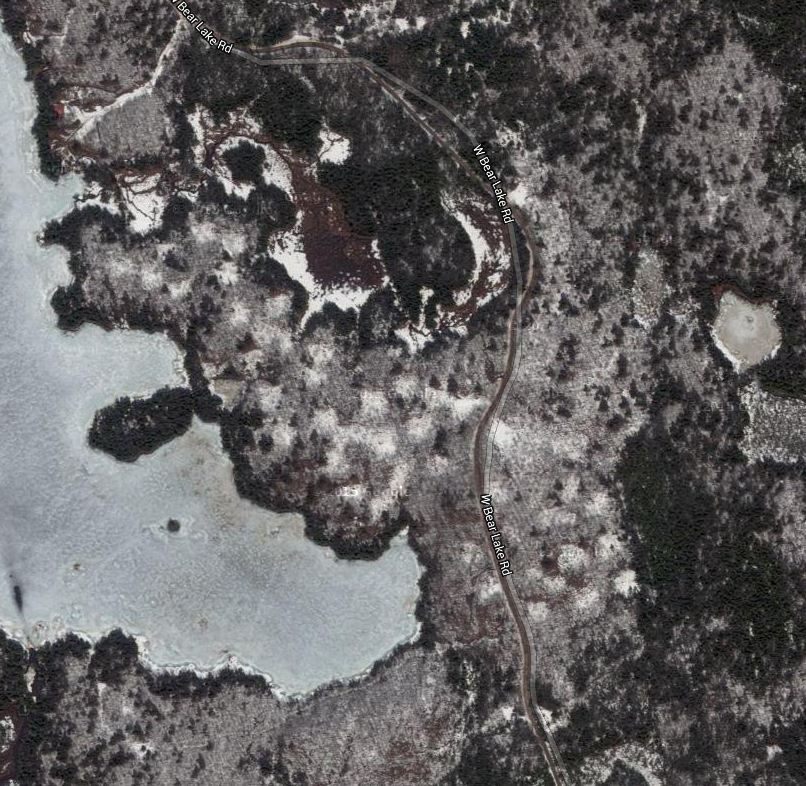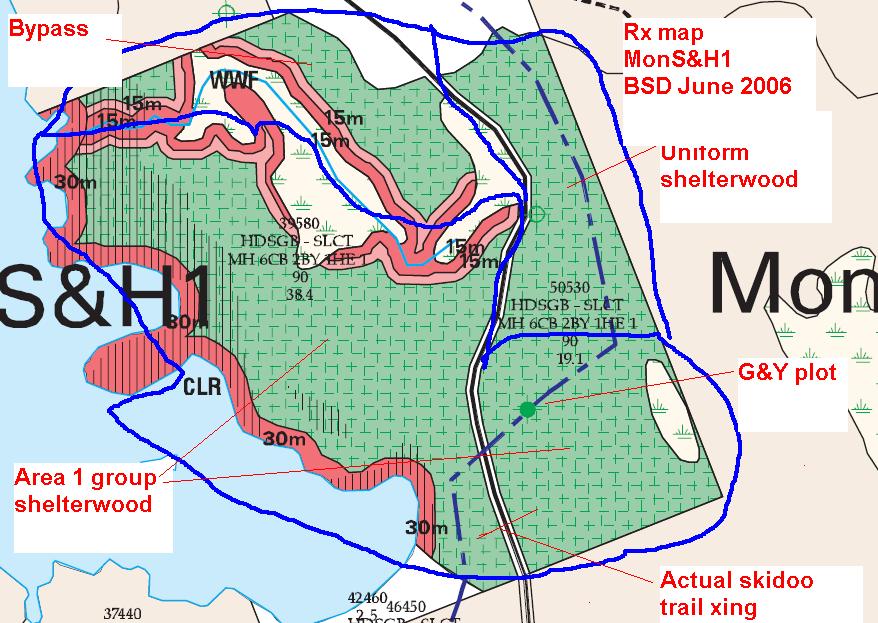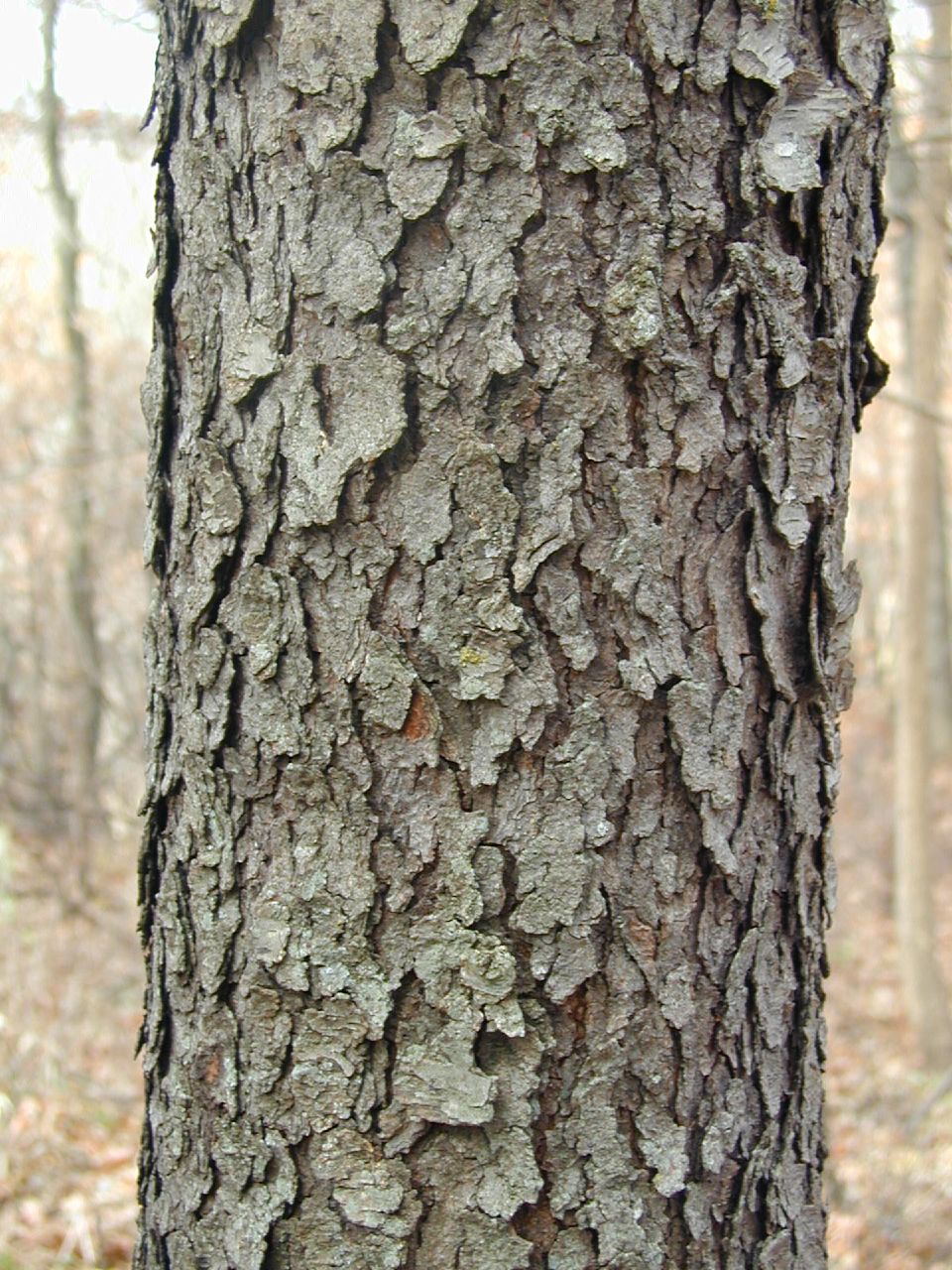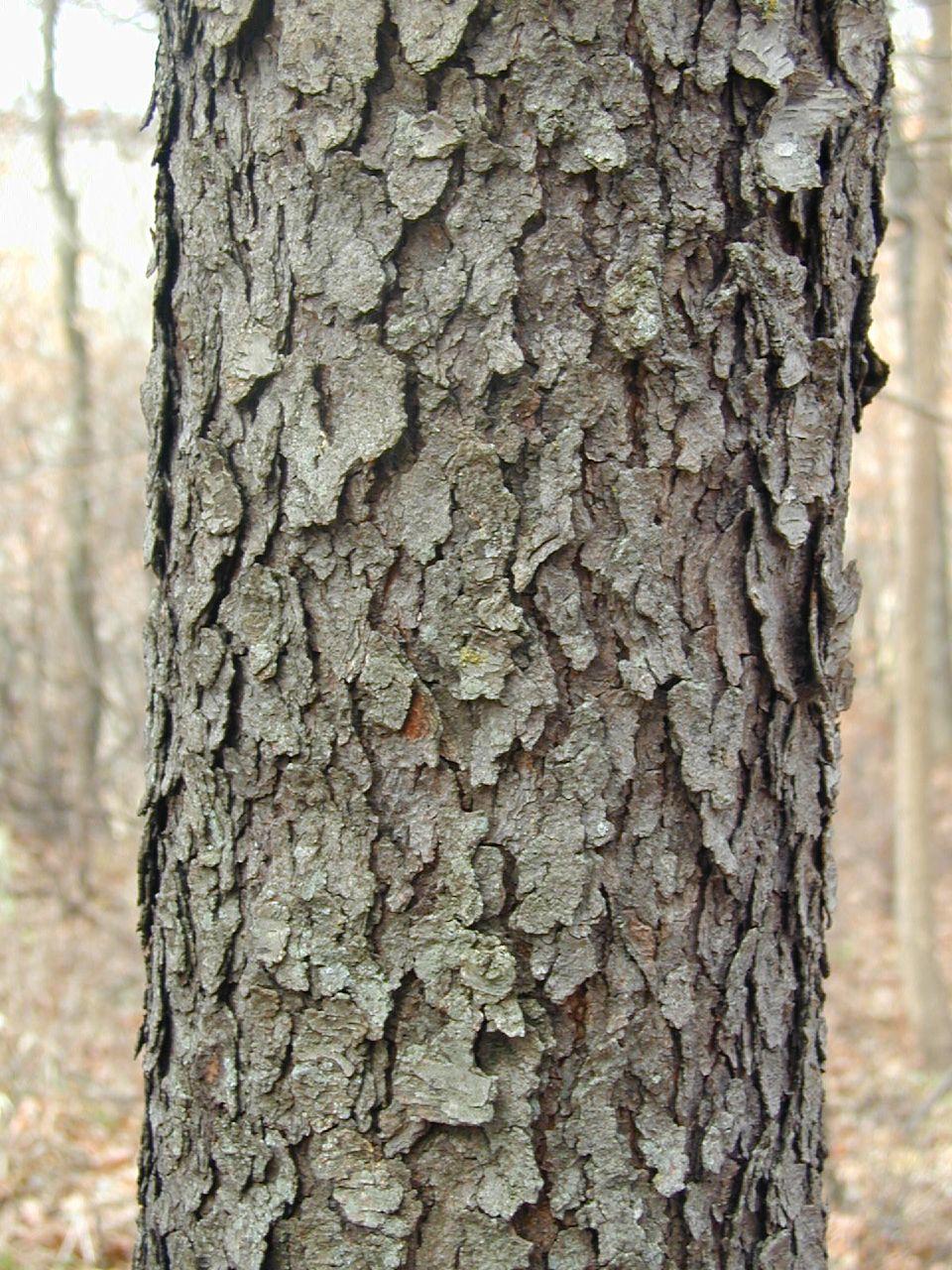Silviculture Objective(s)
The objective is to regenerate black cherry using natural regeneration (seed bank primarily) by:
Area 1- carrying out group shelterwood over 3 harvests spaced approximately 10 years apart
Area 2 – carrying out a 2-cut uniform shelterwood with a return harvest of approximately 10 years.

Figure 1: Google Earth map of treatment site
Pre-treatment stand description and condition
Stand establishment and management history:
Natural origin stand with uncertain cutting history. There is no recent cut record but there is anecdotal history of some stand improvement in the 1970s as well as some unauthorized harvest of some of the larger cherry. The stand improvement is apparent from old stumps although most seem to be thinning clumps of multiple stemmed trees.
The maple is generally of quite poor quality. The hemlock tend to be clumped close to HornLake. Soft maple is of poor quality and there are some very large individuals, undoubtedly with lots of defect and may be cull. The outstanding feature of this area is the quantity and quality of black cherry as well as the size of many of the black cherry. Cherry is scattered throughout the area, with basal areas averaging 4-6m2/ha of black cherry, some areas of up to 18m2/ha of black cherry. The BA of all species varies as well from 12 to 22m2/ha for sawlog sized material. Some of the black cherry is of small diameter (lower end of small sawlog sized), especially on the more shallow soils in the southwest portion of the block in the narrow strip between the lake and the road, just north of the snowmobile trail. However, in many places the diameter is better (upper end of small sawlog sized) and in the bottom slopes where there is more nutrient and moisture the diameters are impressive for this management unit (medium sawlog size class). The trees are generally straight and of quite good quality. Crowns are in quite good condition when compared to many other cherry in the management unit.
On the east side of the road, the cherry is generally not as highly stocked and the maple is of better quality. The cherry tends to be of the size of the larger end of small sawlog sized trees.
A 2003 cruise by inexperienced individuals indicated a total BA of 26m2, 12 of poles and 14 of sawlog size classes with 8.7m2/ha of AGS quality although only 3.7m2 of that was hard maple, the remainder being hemlock, cherry and soft maple.
The understory is primarily advanced sugar maple. West of the road it is more advanced as it is generally 4-6 m tall. Along the ridge in the SW corner it is even taller and more dense. On the east side of the road the maple regeneration is more in the 2-4 m range and generally not as dense. There are pockets of advanced yellow birch, particularly west of the road.
Pre-treatment species composition:
Mh40Cb30Ms10He10By10: Hard maple 40%, black cherry 30%, soft maple 10%, hemlock 10%, yellow birch 10%
Pre-treatment growth and stocking:
Basal Area: total BA averages 26 m2/ha – acceptable growing stock 8.7 m2/ha
Acceptable Growing Stock ~33%. Diameters reasonably well distributed but cherry mostly small sawlog and below. Good growth potential.
Pre-treatment forest health issues:
No significant forest health issues.
Landowner objectives/situation:
Public land subject to provincially regulated forest management planning process administered through a sustainable forest license to a private management company. Forest management plan has an objective to promote cherry and other mid-tolerant hardwoods.
Silviculture Prescription
The block has been divided into 2 areas, one receiving a group shelterwood, the second receiving uniform shelterwood.

Figure 2: Treatment site map
AREA 1 - harvest:
This is a group shelterwood stand with a specified number of groups and sizes. The number of groups will be determined by the size of the groups (roughly 35x35 m=0.12 ha), the area to be managed with group shelterwood (90% of 34 ha=30.6 ha), and the number of cuts (3). So 30.6/3=10.2 ha divided by 0.122 ha/group=83 groups in total. The acceptable range of number of openings is 75 to 84. This allows some flexibility. These openings would be roughly square in shape. However, if by moving out to get one tree that has lots of major defect or is showing major decline, this is acceptable, as is moving in to allow an AGS pole to remain.
The licencee will identify the main skid trails to allow the groups to be oriented in a more logistical fashion. Groups will be separated by approx 75 m in a grid pattern. Slight shifting of a group may take place in order to have 1-3 cherry trees in the middle, or the northern portion of the group. This is not intended to take all the cherry out now, but rather, groups to be managed for cherry will be placed to maximize potential regeneration. At this stage the openings should be centered on at least one large cherry , with at least three cherry within the group. This is the ideal situation but will not always be possible to achieve this in placing 80 or so openings well spaced apart. It is not required to have black cherry on the edge of the opening but if this occurs it is acceptable. (NOTE: cherry in the opening will be harvested).
Openings will avoid groups of hemlock (ideally no hemlock should be in an opening but up to 1 hemlock per opening could fall in an opening [and would be harvested as well]. The calculation of number of openings allows for hemlock patches (found mainly near HornLake) to be avoided.
Not all openings will necessarily be managed for black cherry. If only one small cherry but abundant maple is in the opening then that opening will be identified on the marking report as not to receive any treatment. Similarly, there are some pockets of advanced yellow birch regeneration that can be released through openings. [These should be a priority for release in this harvest entry as leaving them much longer may put their ability to respond at risk. There are not many of these pockets so they should be identified now to be part of a group opening not to be treated for cherry management].
Openings must have a 4 corners marked with a unique plot number assigned. (i.e. P1, P2) and since the majority will be managed for cherry, those that will not, will have two blue horizontal lines above the plot number. This will make for easy identification in the field. In addition, all plots will be identified with a GPS location of approximately the center of the opening, and recorded. The openings on the reporting sheet will state black cherry, yellow birch, or other for black cherry that will receive vegetation management treatment, yellow birch release (no follow-up), or Other (no follow-up). The majority will be black cherry.
All trees will be harvested down to 6 cm dbh in the openings to be managed for cherry. This is to ensure that the smaller poles are harvested. Herbicide treatment will be able to deal with the smaller material.
Some individual trees may be marked along the main skid trail being laid in advance of marking. These should not be quality trees and preferably not cherry trees of medium size classes. This statement is to better allow access into the block with the main trail legitimizing the occasional removal of trees that obviously must be removed.
AREA 1 – follow up silviculture:
Each opening identified for cherry management (the vast majority of openings) will be site prepared using either a basal bark treatment (triclopyr) or ABS sprayer (Vision Max) with the basal bark treatment being the more likely treatment given the height of the understory (>4m) on the west wide of the road. This site preparation is planned preharvest (late summer 2006) prior to the fall harvest. As a backup plan, treatment could occur early in 2007 although some cherry regen would be lost in such a treatment.
Regeneration will be natural, relying mainly on the cherry seedbank as well as seeds to fall in 2006 as the area is not planned to be harvested until the fall 2006 after seedfall and there appears to be a heavy seedcrop given the amount of flowering noticed in late May 2006.
Tending is not anticipated given chemical site preparation work is planned.
AREA 2 - harvest:
This is a uniform shelterwood seeding cut, marking in blue. The stand should be marked to approximately 40-45% crown closure targets. Will be a two pass shelterwood, likely spaced approximately 10 years apart depending on stand response to the first harvest. Given that there is most of the seed in the seedbank already, this is not merely a thin from below approach. However, only very good quality maple poles should be retained in the pole size class. (All hemlock to be retained). The smaller cherry should be retained in order to provide more time to grow, even if it is only a relatively short period of time. Any cherry showing significant decline should be removed. Some larger healthy cherry (in the larger end of the small sawlog size class and medium sized sawlogs) may be removed while some should be retained. (40:60 i.e. 40 to remove, 60 to keep, ratio as a general guide only). This will allow release of the seedbank under those trees that are removed while retaining enough trees to provide mast for wildlife as well as providing enough volume to allow another harvest and provide for another release of the seedbank.
Species priority for retention is hemlock, black cherry, smaller sized sawlogs of good quality maple and yellow birch, beech (few present, secondary mast producer to cherry).
All balsam fir should be removed. Mark down to 6 cm dbh for stand improvement.
AREA 2 – follow up silviculture:
This area will be site prepared using either a basal bark treatment (triclopyr) or ABS sprayer (Vision Max) with the ABS treatment (likely preharvest) being the more likely treatment given the height of the understory (<4m).
Regeneration will be natural, relying mainly on the cherry seedbank as well as seeds to fall in 2006 as the area is not planned to be harvested until the fall 2006 after seedfall and there appears to be a heavy seedcrop given the amount of flowering noticed in late May 2006.
Tending is not anticipated given chemical site preparation work is planned.
What actually happened during the treatment
Harvest and chemical site preparation occurred as per prescription but with fewer groups than planned. Post-harvest screen capture from google maps indicates layout of groups (Figure 1).
Post-treatment assessment
Generally successful with good cherry regeneration but no quantified survey results available at this time.

Figure 3: Black cherry bark (not from this site)
Plans for future treatments
Area 1: Additional groups will be added approximately 10 years post-harvest to establish new regeneration and provide additional light to the regeneration established in the previous harvest. After an additional 10 years the third and final set of groups will be added completing the shelterwood.
Area 2: Final removal will occur approximately 10 years after the first harvest.
Costs and economic considerations
Unavailable.
Other notes
Some of the best mature cherry in this area is the result of old charcoal and chemical cuts that provided very open regeneration conditions. Although cherry is listed as a mid-tolerant, it can do very well in open conditions such as those expected after the second and third cut of the group shelterwood prescription. Openings of 1ha and larger in other recent harvest areas have been shown to have excellent cherry regeneration, particularly when maple advanced regeneration is controlled or not present.
Submitted by
Barry Davidson
Information summarized on behalf of Barry Davidson, Westwind Forest Stewardship Inc. (http://www.westwindforest.ca/)
